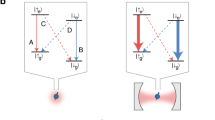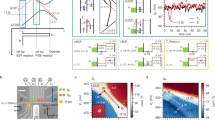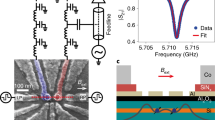Abstract
Readout and control of electrostatically confined electrons in semiconductors are key primitives of quantum information processing with solid-state spin qubits1,2. In superconductor–semiconductor heterostructures, localized electronic modes known as Andreev levels result from confinement that is provided by the pair potential3,4. Unlike electronic modes confined exclusively via electrostatic effects, Andreev levels carry supercurrent. Therefore, they naturally integrate with the techniques of circuit quantum electrodynamics (cQED) that have been developed in the field of superconducting qubits and used to detect pairs of quasiparticles that are trapped in Andreev levels5,6,7,8. Here, we demonstrate single-shot cQED readout of the spin of an individual quasiparticle trapped in the Andreev levels of a semiconductor nanowire Josephson element. Owing to a spin-orbit interaction in the nanowire, this ‘superconducting spin’ directly determines the flow of supercurrent through the element. We harnessed this spin-dependent supercurrent to achieve both a zero-field spin splitting and a long-range interaction between the quasiparticle and a superconducting microwave resonator9,10,11,12,13. Measurement of the resultant spin-dependent resonator frequency yielded quantum non-demolition spin readout with 92% fidelity in 1.9 μs, which enabled us to monitor the quasiparticle spin in real time. These results pave the way for superconducting spin qubits that operate at zero magnetic field and for time-domain measurements of Majorana zero modes9,10,12,14,15.
This is a preview of subscription content, access via your institution
Access options
Access Nature and 54 other Nature Portfolio journals
Get Nature+, our best-value online-access subscription
$29.99 / 30 days
cancel any time
Subscribe to this journal
Receive 12 print issues and online access
$209.00 per year
only $17.42 per issue
Buy this article
- Purchase on Springer Link
- Instant access to full article PDF
Prices may be subject to local taxes which are calculated during checkout




Similar content being viewed by others
Data availability
Source data are provided with this paper. All other data that support the plots within this paper and other findings of this study are available from the corresponding author upon reasonable request.
Change history
29 June 2021
A Correction to this paper has been published: https://doi.org/10.1038/s41567-021-01309-w
References
Hanson, R., Kouwenhoven, L. P., Petta, J. R., Tarucha, S. & Vandersypen, L. M. K. Spins in few-electron quantum dots. Rev. Mod. Phys. 79, 1217–1265 (2007).
Nakajima, T. et al. Quantum non-demolition measurement of an electron spin qubit. Nat. Nanotechnol. 14, 555–560 (2019).
Beenakker, C. W. J. & van Houten, H. Josephson current through a superconducting quantum point contact shorter than the coherence length. Phys. Rev. Lett. 66, 3056–3059 (1991).
Furusaki, A. & Tsukada, M. Current-carrying states in Josephson junctions. Phys. Rev. B 43, 10164–10169 (1991).
Blais, A., Huang, R.-S., Wallraff, A., Girvin, S. M. & Schoelkopf, R. J. Cavity quantum electrodynamics for superconducting electrical circuits: an architecture for quantum computation. Phys. Rev. A 69, 062320 (2004).
Wallraff, A. et al. Strong coupling of a single photon to a superconducting qubit using circuit quantum electrodynamics. Nature 431, 162–167 (2004).
Janvier, C. et al. Coherent manipulation of Andreev states in superconducting atomic contacts. Science 349, 1199–1202 (2015).
Hays, M. et al. Direct microwave measurement of Andreev-bound-state dynamics in a semiconductor-nanowire Josephson junction. Phys. Rev. Lett. 121, 047001 (2018).
Chtchelkatchev, N. M. & Nazarov, Y. V. Andreev quantum dots for spin manipulation. Phys. Rev. Lett. 90, 226806 (2003).
Padurariu, C. & Nazarov, Y. V. Theoretical proposal for superconducting spin qubits. Phys. Rev. B 81, 144519 (2010).
Reynoso, A. A., Usaj, G., Balseiro, C. A., Feinberg, D. & Avignon, M. Spin-orbit induced chirality of Andreev states in Josephson junctions. Phys. Rev. B 86, 214519 (2012).
Park, S. & Yeyati, A. L. Andreev spin qubits in multichannel Rashba nanowires. Phys. Rev. B 96, 125416 (2017).
Tosi, L. et al. Spin-orbit splitting of Andreev states revealed by microwave spectroscopy. Phys. Rev. X 9, 011010 (2019).
Fu, L. & Kane, C. L. Superconducting proximity effect and Majorana fermions at the surface of a topological insulator. Phys. Rev. Lett. 100, 096407 (2008).
Mourik, V. et al. Signatures of Majorana fermions in hybrid superconductor-semiconductor nanowire devices. Science 336, 1003–1007 (2012).
Roy, A. & Devoret, M. Introduction to parametric amplification of quantum signals with Josephson circuits. C. R. Phys. 17, 740–755 (2016).
Petersson, K. D. et al. Circuit quantum electrodynamics with a spin qubit. Nature 490, 380–383 (2012).
Samkharadze, N. et al. Strong spin-photon coupling in silicon. Science 359, 1123–1127 (2018).
Mi, X. et al. A coherent spin-photon interface in silicon. Nature 555, 599–603 (2018).
Harvey, S. P. et al. Coupling two spin qubits with a high-impedance resonator. Phys. Rev. B 97, 235409 (2018).
Landig, A. J. et al. Coherent spin-photon coupling using a resonant exchange qubit. Nature 560, 179–184 (2018).
Cubaynes, T. et al. Highly coherent spin states in carbon nanotubes coupled to cavity photons. npj Quantum Inf. 5, 47 (2019).
Borjans, F., Croot, X. G., Mi, X., Gullans, M. J. & Petta, J. R. Resonant microwave-mediated interactions between distant electron spins. Nature 577, 195–198 (2020).
Zheng, G. et al. Rapid gate-based spin read-out in silicon using an on-chip resonator. Nat. Nanotechol. 14, 742–746 (2019).
West, A. et al. Gate-based single-shot readout of spins in silicon. Nat. Nanotechol. 14, 437–441 (2019).
Urdampilleta, M. et al. Gate-based high fidelity spin readout in a CMOS device. Nat. Nanotechol. 14, 737–741 (2019).
van Woerkom, D. J. et al. Microwave spectroscopy of spinful Andreev bound states in ballistic semiconductor Josephson junctions. Nat. Phys. 13, 876–881 (2017).
Aumentado, J., Keller, M. W., Martinis, J. M. & Devoret, M. H. Nonequilibrium quasiparticles and 2e periodicity in single-Cooper-pair transistors. Phys. Rev. Lett. 92, 066802 (2004).
Governale, M. & Zülicke, U. Spin accumulation in quantum wires with strong Rashba spin-orbit coupling. Phys. Rev. B 66, 073311 (2002).
Sriram, P., Kalantre, S. S., Gharavi, K., Baugh, J. & Muralidharan, B. Supercurrent interference in semiconductor nanowire Josephson junctions. Phys. Rev. B 100, 155431 (2019).
Touzard, S. et al. Gated conditional displacement readout of superconducting qubits. Phys. Rev. Lett. 122, 080502 (2019).
Frattini, N. E., Sivak, V. V., Lingenfelter, A., Shankar, S. & Devoret, M. H. Optimizing the nonlinearity and dissipation of a SNAIL parametric amplifier for dynamic range. Phys. Rev. Appl. 10, 054020 (2018).
Goffman, M. F. et al. Conduction channels of an InAs-Al nanowire Josephson weak link. New J. Phys. 19, 092002 (2017).
Chang, W. et al. Hard gap in epitaxial semiconductor–superconductor nanowires. Nat. Nanotechnol. 10, 232–236 (2015).
Press, W. H., Teukolsky, S. A., Vetterling, W. T. & Flannery, B. P. Numerical Recipes in C++: The Art of Scientific Computing 2nd edn (Cambridge Univ. Press, 2002)..
Acknowledgements
We thank N. Frattini and V. Sivak for providing the SNAIL parametric amplifier. We are grateful to M. Goffman, H. Pothier, L. Tosi, and C. Urbina for sharing their experimental results and thoughts. We thank J. Moreno and A. L. Yeyati for important discussions on the inter-doublet decay dynamics. We are grateful to S. Frolov, L. Frunzio, L. Glazman, M. Houzet, C. Marcus, S. Shankar, and S. Touzard for useful discussions. This research was supported by the US Office of Naval Research (N00014-16-1-2270) and by the US Army Research Office (W911NF-18-1-0020, W911NF-18-1-0212 and W911NF-16-1-0349). J.N. acknowledges support from the Danish National Research Foundation. G.d.L. acknowledges support from the European Union’s Horizon 2020 research and innovation programme under Marie Skłodowska–Curie grant agreement no. 656129. D.B. acknowledges support from the Netherlands Organisation for Scientific Research (NWO) and Microsoft Corporation Station Q. A.G. and J.N. acknowledge support from the Horizon 2020 research and innovation programme of the European Union: A.G. received funding from European Research Council grant no. 804988 (SiMS), and A.G. and J.N. received support from European Research Council grant no. 828948 (AndQC) and QuantERA project no. 127900 (SuperTOP).
Author information
Authors and Affiliations
Contributions
M.H., K.S., D.B., G.d.L., A.G., and M.H.D. designed the experimental setup. P.K. and J.N. developed the nanowire materials. D.B. and A.G. fabricated the device. M.H. and V.F. performed the measurements and developed physical models. M.H., V.F., K.S., S.D., and M.H.D. analysed the data. M.H., V.F., and M.H.D. wrote the manuscript with feedback from all authors.
Corresponding authors
Ethics declarations
Competing interests
The authors declare no competing interests.
Additional information
Peer review information Nature Physics thanks W. Belzig, X. Mi, and the other, anonymous, reviewer(s) for their contribution to the peer review of this work.
Publisher’s note Springer Nature remains neutral with regard to jurisdictional claims in published maps and institutional affiliations.
Extended data
Extended Data Fig. 1 Cryogenic wiring diagram and device micrographs.
Optical micrograph e, is of the device on which the presented measurements were performed. Optical micrographs b, c, d, and scanning electron micrograph f, are of an extremely similar (unmeasured) device, the main difference being that the length of the weak link is 750nm instead of 500nm. The microwave readout and drive tones pass through the depicted circuitry a, before being routed through the Δ port of a 180∘ hybrid resulting in differential microwave voltages at the device input. After reaching two coupling capacitors (c), the readout tone was reflected off the differential λ/4 mode of the coplanar strip resonator (red, frequency fr = 9.18843GHz, coupling κc = 2π × 1.23MHz, internal loss κi = 2π × 1.00MHz) and then routed through the depicted amplification chain (a), which was comprised of a SNAIL parametric amplifier (SPA), HEMT, and room-temperature amplifiers. In this circuit, the drive tone creates an ac phase drop across the nanowire (f), which is embedded in the superconducting Φ-bias loop (green) at the end of the resonator (d,e). One edge of the loop connects the two strips of the resonator and thereby forms the shared inductance with the nanowire. We controlled the electrostatic potential in the nanowire weak link (f) with a dc gate (pink, voltage Vg). Gates on the nanowire leads (orange) were used to gain additional electrostatic control, which were biased to the same voltage Vnw = 0.9V for all presented data. To reference the resonator/nanowire island to ground, an additional strip runs between the resonator strips, and connects to a large finger capacitor (purple). This strip does not significantly perturb the resonator’s microwave properties because it resides at the zero voltage point with respect to the resonator’s differential mode.
Extended Data Fig. 2 Φ-dependence of gc,s.
a, Extracted coupling strengths gc,s for the two inter-doublet spin conserving transitions. The peaks coincide with the minimum frequency of the transitions (Φ = ± Φcross) because this is where the mixing between current and energy eigenstates is strongest (see Supplementary Information Section 1). b, Same data as shown in Fig. 2(d). Solid lines are the predicted χs,1 as in the main text, and dashed lines are the χs,1 if gc,s is assumed to be constant at its maximum value.
Extended Data Fig. 3 Full Φ-dependence of spectrum and dispersive shifts.
a, Φ-dependence of Q over a full half flux quantum. The \(\left|\downarrow ,1\right\rangle\) and \(\left|\uparrow ,1\right\rangle\) distributions (traced with purple and pink splines respectively) remain below the bare resonator Q (black dotted line) over the full Φ range, indicating negative dispersive shifts which are inconsistent with χ resulting from coupling to the inverse inductance operator. The dispersive shift of \(\left|g\right\rangle\) (traced with the gray spline) is likely due to a pair transition with frequency above our measurement bandwidth. We also observe a small number of counts around Φ = 0 at positive Q, indicating a residual quasiparticle population in \(\left|\uparrow ,2\right\rangle\) and \(\left|\downarrow ,2\right\rangle\). Assuming the observed dispersive shift of \(\left|g\right\rangle\) is due only to the properties of the lower doublet, the dispersive shift of a quasiparticle in the upper doublet should be given by χs,2 = − χs,1 + χ0. Based on this formula and the plotted splines, we estimated the Φ-dependence of the \(\left|\downarrow ,2\right\rangle\) and \(\left|\uparrow ,2\right\rangle\) distributions (dashed, teal, and yellow). The predictions track roughly with the residual counts in the vicinity of Φ = 0 before crossing the bare resonator Q. (b) Spectroscopy over the same flux range. The inter-doublet transitions have maximum frequency at Φ = − 0.5Φ0, consistent with Fig. 1(d). We attribute the sign change in the measured \(\Delta \bar{Q}\) to the crossings of χs,1 with \({\it\chi}_{s_2}\) indicated in (a). (c) Attempted modeling of the transitions using the double-barrier model of Ref. 13. Here we extract a chemical potential (as measured from the bottom of a sub-band) of 0.65 meV and a Rashba coefficient of 43 meV*nm. The effective transparencies of the two barriers are t1 = 0.32 and t2 = 0.46.
Extended Data Fig. 4 Spectroscopy of the inter-doublet transitions at the Φ = 0 degeneracy point while Vg is varied.
The transition frequency changes due to mesoscopic conductance fluctuations8,27,33, and a local maximum is observed around Vg = − 1.3592V. The linewidth is visibly narrower at this local maximum, indicating that electric field noise is the dominant source of dephasing. To minimize this dephasing, we performed the measurements presented in the main text at Vg = − 1.3592V.
Extended Data Fig. 5 Brightness of the four inter-doublet transitions as a function of estimated drive power at the device.
At low powers, only the spin-conserving transitions are visible, but as the power is increased the spin-flipping transitions also appear. Note that the spin-flipping transitions at the maximum power (-115 dBm) are still substantially dimmer than the spin-preserving transitions at the lowest power (-140 dBm).
Extended Data Fig. 6 Further detail for the analysis of the Rabi experiment depicted in Fig. 3(d).
a, Histogram of all measurement shots taken during the experiment. Shots inside the dashed circles (radius 2σ) were assigned to the corresponding state. Shots outside these regions were left unassigned. Note that here we also include \(\left|g\right\rangle\) for illustration. b, At each value of the normalized pulse amplitude A, we count the number of points inside each of the four depicted circles in (a). The number of unassigned counts is also plotted. See Methods for further details and comments.
Extended Data Fig. 7 The six extracted transition rates γn,m between \(\left|g\right\rangle\), \(\left|\downarrow ,1\right\rangle\), and \(\left|\uparrow ,1\right\rangle\) as a function of φ and B⊥ at the base temperature of the fridge T = 20mK.
White data points on the spin-flipping rate plots indicate the \(\left|\downarrow ,1\right\rangle\)/\(\left|\uparrow ,1\right\rangle\) degeneracy point at B⊥ = 0 μT, 380 μT (see Main Text Fig. 2(c), Extended Data Fig. 7, Supplementary Information Section 4). The dashed lines connect these points and are guides for the eye.
Extended Data Fig. 8 Spectroscopy at B⊥ = 380 μT.
Note that here there was a slight overall frequency shift due to a change in the electrostatic environment of the nanowire. Here we plot both I (a) and Q (b) to present information in both quadratures. The observed instabilities varied with time, and occurred when operating our flux coil at high current. The same data is plotted in (c)/(d), but with overlaid fits. We describe the data by the model used in Fig. 2(c), but we include an additional Zeeman-like term (see Supplementary Information Section 4).
Extended Data Fig. 9
The six extracted transition rates γn,m between \(\left|{g}\right\rangle\), \(\left|{\downarrow },{1}\right\rangle\), and \(\left|{\uparrow },{1}\right\rangle\) as a function of φ and mixing chamber temperature T at B = 0μT.
Supplementary information
Supplementary Information
Supplementary Discussion
Source data
Source Data Fig. 2
Source data for Fig. 2.
Source Data Fig. 3
Source data for Fig. 3.
Source Data Fig. 4
Source data for Fig. 4.
Rights and permissions
About this article
Cite this article
Hays, M., Fatemi, V., Serniak, K. et al. Continuous monitoring of a trapped superconducting spin. Nat. Phys. 16, 1103–1107 (2020). https://doi.org/10.1038/s41567-020-0952-3
Received:
Accepted:
Published:
Issue Date:
DOI: https://doi.org/10.1038/s41567-020-0952-3
This article is cited by
-
Phase-dependent Andreev molecules and superconducting gap closing in coherently-coupled Josephson junctions
Nature Communications (2023)
-
Direct manipulation of a superconducting spin qubit strongly coupled to a transmon qubit
Nature Physics (2023)
-
Microwave spectroscopy of Andreev states in InAs nanowire-based hybrid junctions using a flip-chip layout
Communications Physics (2022)
-
Hybrid light-matter networks of Majorana zero modes
npj Quantum Information (2021)
-
From Andreev to Majorana bound states in hybrid superconductor–semiconductor nanowires
Nature Reviews Physics (2020)



